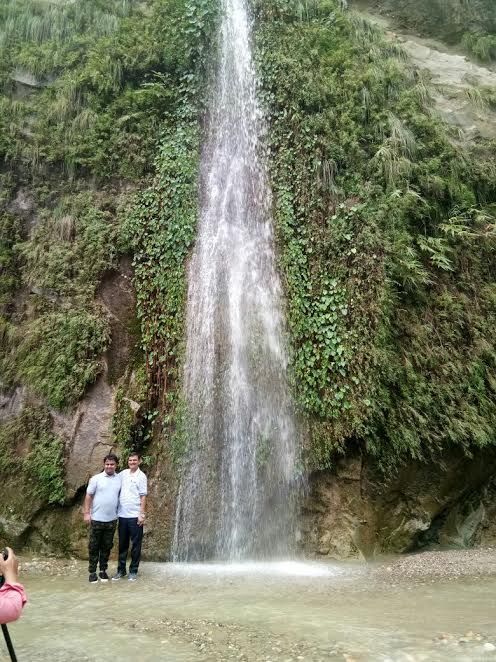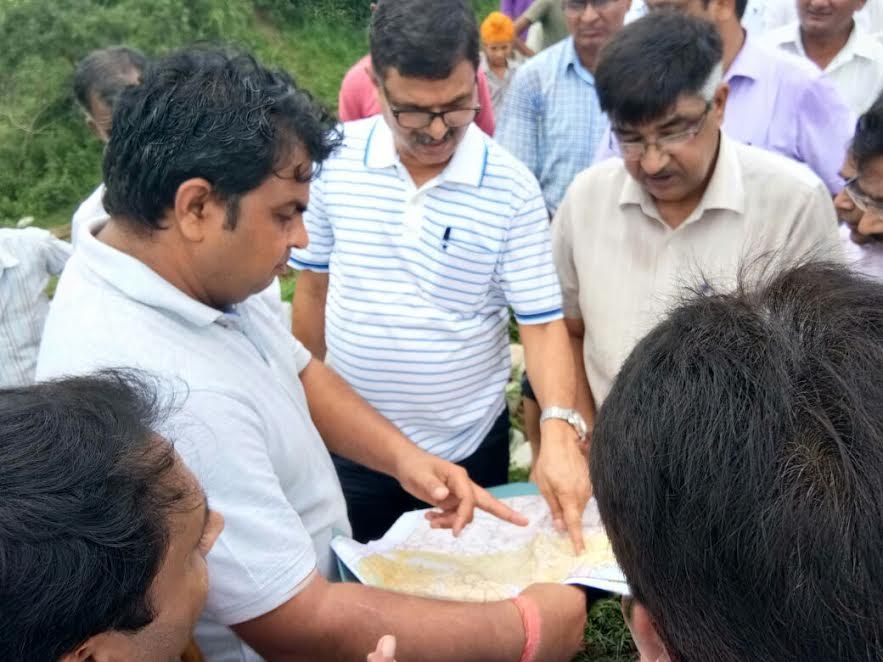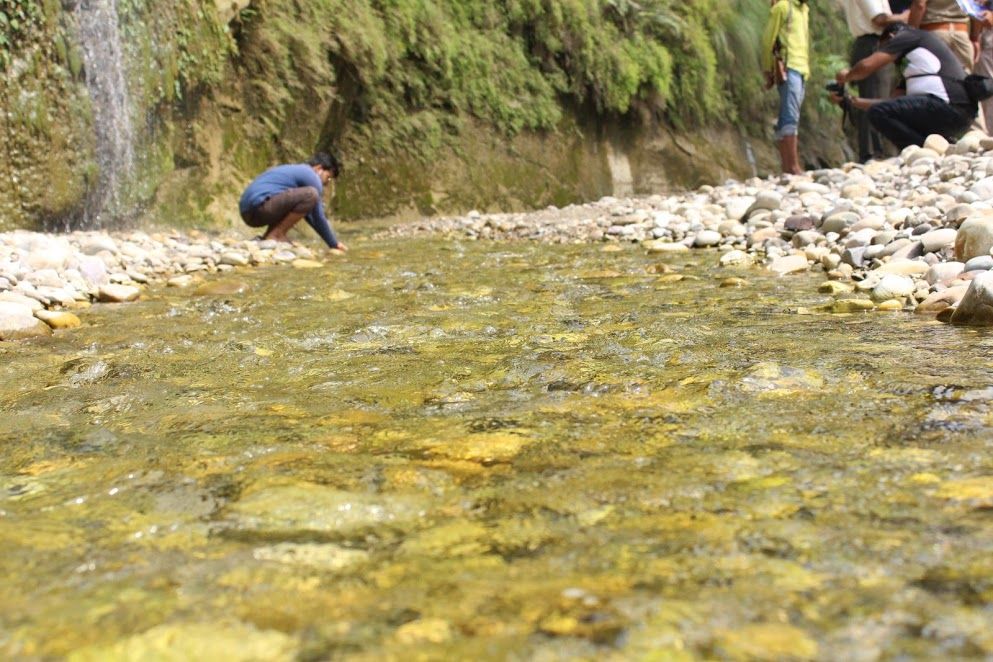Hindon Origination & Introduction
Kaluwala Khol i.e. Hindon River starts from Shivalik mountain range near Kaluwala. It is a monsoon-fed river. Many smaller streams flow into it. Distributing Uttar Pradesh and Uttarakhand borders in Saharanpur district, this Shivalik mountain range has a stream originating in its south near Kaluwala and Khothri milaan which is known as Barsani River. Other smaller streams namely Strot, Chajjewali, Peerwali, Sapoliya, Khothri and Andhakundi flow into Barsani. Also present is the Shivalik reserved forest area which includes forest ranges of Mohand, Shahjahanpur, and Shakumbhri.
The distance between Shivalik ranges facing towards Uttar Pradesh and the border of forest reserve is around 15 kms. In this whole stretch of 15 kms, Hindon is surrounded by dense forest and mountains on both sides. Most of the rainwater flows into Hindon stream down from the mountains sometimes passing along trees in the forest. The river receives a great amount of waters in monsoons and flows downstream. All the small streams join themselves and Hindon are originated which also consumes the stream which flows from Pur ka Tanda village, at Kamaalpur village. The residents of the villages on the upper side of the range and Van Gujjar community has given different names to Hindon, such as Barsani, Kaluwala khol and Guleria, but use these names only to distinguish different lengths of the stream.

Hindon River was till now was believed to be originating from forests of Pur ka Tanda village in Saharanpur village but according to British Gazatier and Satellite mapping, it actually originates from the Kaluwala village at Shivalik mountain range in Muzaffarabad block of Saharanpur district. It passes from districts Saharanpur, Muzaffarnagar, Meerut, Baghpat, and Ghaziabad traveling for 355 km before finally meeting the Yamuna River at forests of Momnathal village situated about 500 m from Tilwada village in Gautambudhnagar district. There are about 865 villages situated near Hindon and its tributary rivers.

The water collected in monsoons at Pur ka tanda village flows as a stream. Irrigation dept has also constructed two small check dams in the forests here to collect water. This stream flows into Hindon River i.e. Kaluwala khol, which carries pure and clear waters from Shivalik mountain range, at forests of Kamaalpur village. About 90 % of the stream water is carried by Hindon itself and rest are contributed by the stream of Pur ka tanda.
Flow of Hindon
After crossing Saharanpur district, this river enters Muzaffarnagar and Shamli districts. Hindon River has been used to mark as borders for these two districts. Muzaffarnagar falls in east and Shamli at the west side of the Hindon. In both of these districts, Hindon receives agricultural runoffs in addition to solid-liquid wastes of Budhana village. As soon as Hindon enters Meerut district, in Meerut – Muzaffarnagar border in forests of Pithlokar village, Kali (West) River flowing from the east, flows into Hindon.
After Muzaffarnagar – Shamli, Hindon enters Meerut and Baghpat districts. Even these two district’s borders have been marked using Hindon River. Meerut falls in east and Baghpat on the west side of Hindon. Flowing forward for nearly 10 km, Hindon receives Krishna stream from the west near Barnawa village. But before Barnawa, a filthy drain has also entered Hindon in forests of Kalina village coming from Sardhana village in the east of Meerut district.
As Hindon moves forward, at its east in Meerut District, about 1500 cusecs water is added to Hindon from Jaani escape of Upper Ganga River. The capacity of Jaani escape is about 2000 cusec to add waters. This happens in the forests of Mohammad dhoomi village which is about 2 km before Meerut-Baghpat road. Henceforth the flow of river increases from here and also its waters get cleaner. The water here was added for the purpose of further extraction at Mohannagar through the medium of a river to send it towards Agra city. Furthermore, Hindon receives un-treated liquid and solid wastes from numerous industries and villages along its length before entering Ghaziabad borders. Challenges are further increased for Hindon in Ghaziabad as it receives a heavy amount of pollution in form of city sewage, solid wastage and liquid waste discharge of industries, throwing the river in the most critical condition where it also faces encroachment of its basin too.
Waters of Hindon River are controlled by a dam at Mohannagar in Ghaziabad where only about 30% of the waters are allowed for further flow. Rest of the water is directed west towards Yamuna River in Kalindi Kunj Dam. This stream flowing from Mohannagar dam meets Yamuna waters from the east side and the same amount of waters added to the Yamuna here, is sent towards Agra River from west of Yamuna River. Therefore, the water added to Hindon at Jaani escape is actually sent to Agra River passing from Mohannagar and Kalindikunj.
Hindon keeps receiving sewage and industrial wastages even at Mohannagar dam. After leaving this dam, Hindon enters Gautambudhnagar where more serious challenges await it. More of the sewage, non treated harmful industrial waste and encroachment await Hindon here which almost kills the river but somehow Hindon reaches Yamuna River. Around 2 km before this merging point, Hindon receives about 400 cusecs of waters at the east side from upper Ganga River, but even this water boost doesn’t help Hindon much to gain its life back from its poisoned condition.
Source of Water
The main source of water in Hindon is rain and stream waters. At origination itself, high quantities of rainwater are received which flows about 100 m wide for 3-4 feet deep. Some of the water is contributed by water runoffs from roots of trees in the dense forest of the Shivalik range. In the whole length of Hindon, 3000 cusecs of water is added from upper Ganga stream and its tributary streams at four locations. The tributary named Barsani fall adds water all year round to Hindon. This fall is around 100 feet high.
In the year 1978, Hindon has the highest record of water flow of 1, 30, 000 cusec. It has been highest yet till now.
Rainy River
Hindon is a rainy river as it receives a high amount of waters in monsoon season (July to September) but flows polluted in other months (October to June) due to less water and wastage, sewage disposal in it.
Tributary Rivers
Main tributary rivers of Hindon are Kali west, Krishni, Pur ka Tanda River, Dhamola, Paavdhoi, Sheela, Naagdev and Chacha raav. And supporting streams consist of Barsani, Sapolia, Chajjewali, Peerwali, Khothri, Andhakundi, and Stroti. These all together give life to Hindon by flowing into it at different locations.
Naagdev River also originates from Shivalik Mountains at the west side of Hindon River. It flows for about 45 km before merging with Hindon in forests of Ghorki village of Saharanpur district. It flows heavily in the rainy season and acts as the main source of waters in Hindon.
Another main tributary Kali west River originates from eastern side of Hindon in Gangali village of Saharanpur district and flows for nearly 145 kms before merging with Hindon at forests of Pithlokar village of Muzaffarnagar district. A tributary stream Sheela which starts from Chudiyala already flows into Kali west in Matoli village near Deoband. Before meeting Hindon, Kali west receives 1000 cuesec of waters through the medium of a drain from upper Ganga Stream Khatauli at forests of Ambarpur village which fall 25kms before Muzffarnagar city. At present due to technical issues, waters are not being transferred.
Also, 100 cusec of waters are being added to Kali west from Bhanera escape in Saharanpur district, again from upper Ganga stream. Kali West is one of the most polluted rivers in our nation as it receives un-treated wastes of about 80 small and large industries of Muzaffarnagar district along with household liquid waste. The point where Kali west merges with Hindon, it contributes to 80% of the Hindon waters there.
Krishni flows in the east of Hindon from Darari village of Saharanpur district and crosses Shamli and Baghpat districts before merging with Hindon in forests of Barnawa village of Baghpat district. It flows for about 153 km. This river also receives a heavy amount of pollutants in form of non treated wastes of industries of Nanota, Sikka, Thanabhawan, Charthawal, Shamli, and Banghpat along with household waste disposal which finally goes into Hindon.
Dhamola River which starts from Sansarpur village of Saharanpur district in the west of Hindon flows for about 25 km before merging with Hindon in forests of the historical Sharkathal village in Saharanpur district itself. This village is “Majra” of Sadoli Hariya village which makes it historical. Dhamola’s tributary stream Paavdhoi starts from Shanklapuri village of Saharanpur district where a historical Shiva temple exists. Two monsoons drains namely Khurd and Gun kat originating from Meherbaani village also flow into Paavdhoi stream. Flowing forward for nearly 7 kms from Shanklapuri village, Paavdhoi enters Dhamola in Saharanpur city. Paavdhoi starts with clean waters which it receives from underground sourcing natural way “chauye” but until reaching Dhamola it gets heavily polluted by un-treated wastes of Saharanpur city. Dhamola receives whole sewage waters of Saharanpur city along with Paavdhoi’s polluted waters and flows into Hindon with its totally polluted waters.
Hindon & Its Tributaries

- Hindon River, Origination- Shivalik mountain range (Village Kaluwala Rai, Dist Saharanpur, U.P.) , Meet point- Village Tilwada/Momthal, Dist Gautambudhnagar, U.P., Length- 355
- Krishni River, Origination- Darari village, Saharanpur district, U.P., Meet point- Village Barnawa, Baghpat dist, U.P., Length- 153
- Kali River west, Origination- Gangali village, dist Saharanpur, U.P., Meet point- Village Atali/Pithlokar, dist Muzafarnagar/Meerut, U.P., Length- 145
- Sheela River, Origination- Village Bhagwanpur, Dist Haridwar, U.K. , Meet point- Village Matauli, Dist. Saharanpur, U.P., Length- 61
- Dhamola River, Origination- Sansarpur village, Saharanpur dist, U.P., Meet point- Village Sharakthal/Sadoli Hariya, dist. Saharanpur, U.P., Length- 52
- Pavdhoi River, Origination- Village Shanklapuri, dist Saharanpur, U.P., Meet point- Saharanpur city, U.P., Length- 7
- Naagdev Rau, Origination- Village Khothri, Shivalik mountain range, Saharanpur dist, U.P., Meet point- Village Ghorki, Saharanpur dist, U.P., Length- 45
- Chacha Rau, Origination- Village Kaluwala, Saharanpur dist, U.P., Meet point- Village Kamaalpur, Saharanpur dist, U.P., Length- 18
Pollution and Industries
Three main sources of pollution in Hindon are
- non-treated wastes of industries,
- city sewage,
- and agricultural runoff.
The initiation of heavy pollution can be witnessed in Paraagpur village of Saharanpur district where non treated liquid wastes of Star paper mill is disposed of in Hindon through a drain. Before this point, Naagdev carries wastes of many small industries which are added to Hindon at Naugaja Peer, but in a smaller quantity. Until Hindon merges with Yamuna River, more than a dozen drains flow into it carrying heavily polluted waters that Hindon waters turn black and give a foul smell. The whole length of Hindon from Paraagpur village to Tilwada village in Gautambudhnagar district, all the sewage and waste disposal makes the river alarmingly polluted that no living organism is able to sustain in it.
There are about 316 industries in total which are situated on/near banks of Hindon and its tributaries in all of seven districts. Apart from these, 07 industries (5 Pulp and paper & 2 Sugarcane mills) are located near Sheela river’s bank which flows in Haridwar district and merges with Kali west river. Hence, total of 323 industries pollutes Hindon directly/indirectly with their un-treated liquid and treated wastes.
According to Uttar Pradesh Water Dept, 1215.43 MLD of sewage is produced from Saharanpur, Muzaffarnagar, Budhana, Baghpat, Meerut, Ghaziabad and Noida city which is transported through 68 drains. About 450 MLD of this sewage is being filtered in different city systems but rest 765.43 MLD is unfiltered due to unavailability of sewage treatment system. All of it is disposed of in Hindon River and its tributaries.
Effects of Pollution
Due to flowing polluted waters of Hindon and its tributaries, underground waters of villages established on banks of these rivers has also turned poisonous. Several villages are witnessing water borne diseases. Many deaths have been reported caused by deadly diseases caused straight to polluted water consumption. Even some farmers still use these polluted waters for irrigating their crops due to unavailability of alternate water source, which has caused presence of banned Persistent Organic Pollutants in the field soil and crops. Under the orders of National Green Tribunal, large numbers of hand pumps have been extracted from villages residing near Hindon and its tributaries. Once these rivers were the reason to cause communities reside near them but now their condition is forcing them to evacuate. The pollution level has become so high making it untouchable but also hard to even stand nearby. According to aged residents, once these waters were so clear that one could look at a coin lying under water but today one cannot see one’s own palm lines when river water is taken in hand.
And at the end, our once very lively river Hindon originating from Shivalik mountain range merges with Yamuna waters at east of Momnathal & west of Tilwada village in a very quiet manner stating its painful journey. Even Yamuna River witnesses painful condition of Hindon waters and welcomes it quietly. Both the rivers merge into one and flow forward.
Raman Kant
Director/Member
NEER Foundation/ Nirmal Hindon
94116 76951






 tag on profile.
tag on profile.
By Raman Kant {{descmodel.currdesc.readstats }}
Raman Kant {{descmodel.currdesc.readstats }}
Hindon Origination & Introduction
Flow of Hindon
Source of Water
Rainy River
Tributary Rivers
Hindon & Its Tributaries
Pollution and Industries
Effects of Pollution
Attached Images